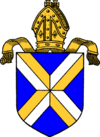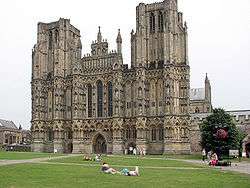Diocese of Bath and Wells
| Diocese of Bath and Wells | |
|---|---|
 | |
| Location | |
| Ecclesiastical province | Canterbury |
| Archdeaconries | Bath, Wells, Taunton |
| Statistics | |
| Parishes | 477 |
| Churches | 569 |
| Information | |
| Cathedral | Cathedral Church of Saint Andrew |
| Current leadership | |
| Bishop | Peter Hancock, Bishop of Bath and Wells |
| Suffragan | Ruth Worsley, Bishop of Taunton[1] |
| Archdeacons |
John Reed, Archdeacon of Taunton Andy Piggott, Archdeacon of Bath Nicola Sullivan, Archdeacon of Wells |
| Website | |
| bathandwells.org.uk | |
The Diocese of Bath and Wells is a diocese in the Church of England Province of Canterbury in England.
The diocese covers the county of Somerset and a small area of Dorset. The Episcopal seat of the Bishop of Bath and Wells is located in the Cathedral Church of Saint Andrew in the city of Wells in Somerset.
History
Early name variation
Before 909, Somerset lay within the diocese of Sherborne. At this date, Athelm (later Archbishop of Canterbury) was appointed the first bishop of the Diocese of Wells, making the secular church there into the diocesan cathedral. The secular canons at Wells vied with the monks of the monasteries at Glastonbury and Bath for supremacy in the diocese and it was with difficulty that the cathedral retained its status, so much so that the canons were reduced to begging in order to obtain their bread. It was to this impoverished cathedral church that Gisa was appointed bishop in 1060. Under him, grants of land were obtained successively from the kings Edward the Confessor, Harold and William the Conqueror and buildings were constructed for the secular community.

Gisa's successor, John de Villula (1088–1122), moved the see to become the Diocese of Bath in 1090, using the Abbey Church of Ss Peter & Paul as his cathedral and in so doing he regressed the position of the cathedral at Wells. Robert of Lewes, appointed bishop in 1136, enhanced on the position of Wells. As well as rebuilding the cathedral he instituted the arrangement by which although Bath retained precedence, the seat was located in both churches and the bishop was elected by both chapters. However the diocesan title remained the same.
Reginald fitz Jocelin (bishop 1174–91) brought Saint Hugh of Lincoln to England and his successor, Savaric FitzGeldewin (1192–1205) forcibly annexed Glastonbury Abbey to the diocese in 1197. He moved his seat there, with the approval of Pope Celestine III, and the see became officially known as the Diocese of Glastonbury. The monks of Glastonbury, however, rejected Savaric's authority and the title Diocese of Bath and Glastonbury was therefore used for all practical purposes until his successor, Jocelin of Wells, a native of Wells itself, renounced the claim to Glastonbury in 1219. Thereupon he adopted the style Diocese of Bath. Although he did not use the name of Wells in his title, his contribution to the city was greater than any other bishop of the diocese: under his authority the cathedral was restored and enlarged, adding the west front, making this the visual signature of the building. Further, he increased the thirty-five canons to fifty and founded a grammar school for the city.
Following his death in 1242 however, the monks at Bath unilaterally elected one of their number, Roger, as successor, in disregard for the chapter of Wells. His appointment received confirmation from King Henry III and the new pope Innocent IV. The chapter at Wells appealed the decision, with the result that the Pope declared, on 3 January 1245, that whilst Roger should remain, he would be bishop of a see thenceforth styled the Diocese of Bath and Wells.
Medieval diocese of Bath and Wells
The diocese of Bath and Wells proper (Badoniensis et Wellensis) dates therefore from 1245. The diocese contained the three archdeaconries of Bath, Wells, and Taunton. William of Bitton bishop from 1267–74 was renowned for his piety, and his tomb became a place of pilgrimage in Wells. The completion of the buildings was achieved under Ralph of Shrewsbury (bishop 1329–63). Thomas Beckington (bishop 1443–65) was another noted liberal benefactor of the city.
Oliver King (1495–1503) rebuilt Bath Abbey in the late Perpendicular style. The work was begun in 1499 and completed in 1530 under John Clerk. The abbey was the last complete monastic edifice to be completed before the impending Reformation. He was succeeded by Adriano Castellesi (1504–18) who was an absentee bishop, under whom the see was administered by Polydore Vergil the noted historian. Castellesi's successor Thomas Wolsey (1518–23) was also an absentee bishop, held the see concurrently with that of York.
Reformation
The abbey at Bath was dissolved by King Henry VIII in 1538 during the English Reformation. Thereafter the Church of England bishop, though retaining the old style, had his seat at Wells alone. William Barlow, was appointed in 1548. He fled in 1553 on the accession of Queen Mary I, and his successor was the Roman Catholic Gilbert Bourne (1554–59), who was deprived and imprisoned in the Tower of London by Queen Elizabeth, becoming, in 1569, one of the eleven Roman Catholic bishops who died in prison.
Contemporary diocese
The diocesan offices, the bishops' offices and residences and the cathedral are all located in Wells. The diocese is not referred to as Bath diocese or Wells diocese, but as Bath and Wells diocese.[2]
Bishops
The ordinary of the diocese is the diocesan Bishop of Bath and Wells, Peter Hancock; he is assisted throughout the diocese by the Bishop suffragan of Taunton (Ruth Worsley, whose See was created in 1911.) Alternative episcopal oversight (for parishes in the diocese who reject the ministry of priests who are women) is provided by the provincial episcopal visitor (PEV) the, Bishop suffragan of Ebbsfleet, Jonathan Goodall. The bishop is licensed as an honorary assistant bishop of the diocese in order to facilitate his work there.
There are seven retired honorary assistant bishops licensed in the diocese:
- 1992–present: Richard Third, retired Bishop suffragan of Dover, lives in Broadclyst in the Diocese of Exeter.[3]
- 1993–present: Retired Bishop suffragan of Doncaster William Persson lives in Marnhull in neighbouring Salisbury diocese.[4]
- 2001–present: Paul Barber, retired Bishop suffragan of Brixworth, lives in Street, Somerset.[5]
- 2003–present: Barry Rogerson, retired Bishop of Bristol, lives in Clevedon.[6]
- 2003–present: Roger Sainsbury, retired area Bishop of Barking, lives in Portishead, Somerset.[7]
- 2009–present: Retired Bishop of Southwell and Nottingham George Cassidy lives in Stogursey.[8]
- 2011–present: Retired Bishop of Chelmsford John Perry lives in Combe Down.[9]
Additionally the twin brother bishops Michael Ball (retired Bishop of Truro) and Peter Ball (retired Bishop of Gloucester), founders of the Community of the Glorious Ascension, live together in the diocese (in Aller, Somerset.)[10][11]
Diocesan structure
The diocese is divided into three archdeaconries: Bath, Taunton and Wells. These in turn are divided into 18 deaneries:
- Axbridge
- Bath
- Bruton and Cary
- Chew Magna
- Crewkerne and Ilminster
- Exmoor
- Frome
- Glastonbury
- Ivelchester
- Locking
- Midsomer Norton
- Portishead
- Quantock
- Sedgemoor
- Shepton Mallet
- Taunton
- Tone
- Yeovil
References
- ↑ Diocese of Bath & Wells — Ruth Worsley announced as next Bishop of Taunton (Accessed 2 July 2015)
- ↑ Diocese of Bath and Wells – The Bishops' Office
- ↑ Third, Rt Rev. Richard Henry McPhail. Who's Who 2014 (December 2013 online ed.). A & C Black, an imprint of Bloomsbury Publishing plc. Retrieved 25 April 2014.
- ↑ "The Rt Revd William Michael Dermot Persson". Crockford's Clerical Directory. Retrieved 3 November 2015. (subscription required (help)).
- ↑ Barber, Rt Rev. Paul Everard. Who's Who 2014 (December 2013 online ed.). A & C Black, an imprint of Bloomsbury Publishing plc. Retrieved 25 April 2014.
- ↑ Rogerson, Rt Rev. Barry. Who's Who 2014 (December 2013 online ed.). A & C Black, an imprint of Bloomsbury Publishing plc. Retrieved 25 April 2014.
- ↑ Sainsbury, Rt Rev. Dr Roger Frederick. Who's Who 2014 (December 2013 online ed.). A & C Black, an imprint of Bloomsbury Publishing plc. Retrieved 25 April 2014.
- ↑ Cassidy, Rt Rev. George Henry. Who's Who 2014 (December 2013 online ed.). A & C Black, an imprint of Bloomsbury Publishing plc. Retrieved 25 April 2014.
- ↑ Cassidy, Rt Rev. John Freeman. Who's Who 2014 (December 2013 online ed.). A & C Black, an imprint of Bloomsbury Publishing plc. Retrieved 25 April 2014.
- ↑ Bell, Rt Rev. Michael Thomas. Who's Who 2014 (December 2013 online ed.). A & C Black, an imprint of Bloomsbury Publishing plc. Retrieved 25 April 2014.
- ↑ Bell, Rt Rev. Peter John. Who's Who 2014 (December 2013 online ed.). A & C Black, an imprint of Bloomsbury Publishing plc. Retrieved 25 April 2014.
Sources
- L. S. Colchester. (1982). Wells Cathedral: A History. Open Books
- The Catholic Encyclopedia
- Church of England Statistics 2002
External links
| ||||||||||||||||||||||||||||||
| ||||||||||||||
Coordinates: 51°12′37″N 2°38′34″W / 51.21028°N 2.64278°W